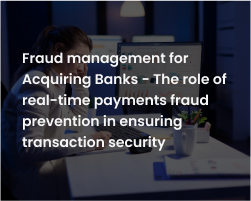5 Top Reasons Why Real-Time Fraud Detection Is Necessary to Secure UPI Transactions
Introduction
Looking at the frequency and changing nature of UPI transaction frauds, it is evident that UPI fraudsters can outpace financial organisations in using the latest technology. Long before the financial institutions develop and implement security measures, fraudsters do their jobs. It is essential for financial institutions, including banks and payment services providers, to adopt real-time detection mechanisms to ensure better security and transparency in UPI transactions, thereby strengthening customer trust across demographic segments in the overall online payment ecosystem.
Advanced phishing, identity theft, SIM swap attacks, QR code scams, fake UPI accounts, and so on— banks face all such new-age UPI frauds frequently these days. Traditional processes like rule-based systems and manual review processes are no longer enough to handle these modern fraud activities. Only real-time fraud detection, a more secure and advanced measure, can be helpful in this matter.
However, a lack of awareness about real-time monitoring is still seen, and it is neither acceptable nor affordable. To help banks and other financial institutions understand the significance of real-time payment fraud detection, this blog highlights the major reasons why it is essential to adopt.
What is Real-time Fraud Detection?
Unlike conventional fraud detection techniques, real-time fraud detection is a method involving self-learning cognitive machine learning (ML), other advanced AI-powered capabilities, and data management systems to immediately identify potential threats of fraud before it causes significant financial losses for banks and their customers. Its work process combines comprehensive analysis and smart methods, ensuring better efficiency and accuracy than traditional fraud identification techniques.
It works by first collecting and analysing a huge amount of data, which helps to spot distinguishing patterns between normal transactions and fraud. In the next step, the behaviour of a particular financial account, like a UPI account, is analysed using artificial intelligence and machine learning. The real-time fraud detection technique also comprises identity verification processes before initiating any transaction, which strengthens the security of online transactions.
Considering today’s popularity of UPI payment methods, cybersecurity experts nowadays emphasise using real-time payment fraud detection so both the receiver and sender in any UPI transaction remain safe from any online UPI fraud.
5 Reasons Why Opting for Real-time UPI Fraud Detection is Essential
The financial year of 2024-25 has already recorded 6.32 lakh UPI fraud incidents involving ₹485 crore—nearly half of last year’s numbers, which were ₹1,087 crore. The data hints at how it has become a serious concern, and the necessity for an effective UPI fraud prevention strategy becomes prominent. In this scenario, adopting real-time payment fraud detection is not optional but a mandatory measure to consider. Here are the reasons why real-time fraud detection is critical to avoid or address the online UPI fraud issues.

Prevents the risks of financial losses quickly:
Although traditional fraud prevention systems help to lower financial losses caused by fraud, real-time monitoring goes a step ahead by making the process faster and reducing the risks to almost zero. With its proactive approach and advanced features, it instantly identifies the chances of UPI PIN fraud or UPI ID scams. It then alerts the user and the respective organisations involved in the transactions about the possible fraud, helping them to take necessary measures.
Saves time, cost, and resources:
Conducting conventional fraud detection techniques, including manual supervision and investigation, involves a significant amount of time, cost, and manpower for an organisation. Even after that, complete accuracy is not ensured. Utilising real-time monitoring empowered by new-age technology, you can detect UPI transaction fraud more efficiently with fewer resources and time. Thus, you can use the time and resources on other tasks. Moreover, the possible costs of legal proceedings, payment recovery efforts, etc., are saved.
Stops the new-age fraud techniques:
Today’s fraudsters’ activities are not limited to any fixed patterns. They manipulate the personal information, such as user location, device details, account credentials, etc., to deceive banks and their customers. Considering this multi-dimensional nature of fraud, using real-time fraud detection has become critical for banks. This method has high-end adaptive intelligence to identify any new pattern of fraud. On the other hand, it can monitor signals from diverse sources in real time to detect anomalies.
Avoids non-compliance with cybersecurity laws:
Frequent chargebacks, complaints of UPI PIN frauds or UPI ID scams, may put an organisation’s compliance with cybersecurity laws at risk. If frequent chargebacks are reported under any bank, non-compliance fees may have to be paid for not meeting the cybersecurity regulations criteria. Ensuring timely detection of fraud, real-time monitoring always helps to stay compliant with the ever-changing security regulations for UPI transactions and other online payment modes.
Increases brand reputation and reliability:
Whether it is an online UPI payment service provider or a bank, reputation and positive user experience are a primary concern for them, as they determine the institution’s reliability among customers. The frequent cases of UPI fraud hinder business growth and prevent the organisation from creating a positive impression. Customers also become victims of fraud, which deteriorates their experience with the financial institution. With the help of the real-time payment fraud detection technique, security against UPI transaction fraud is strengthened, which makes the brand stand out and more trustworthy than ever for its existing customers and new ones, improving their experience.

So, to mitigate the risks of financial losses, save UPI fraud-related costs, and maintain positive customer relationships, embracing the real-time fraud detection method is crucial.
Types of Frauds that Real-time Fraud Detection Covers
With the growing usage of UPI payments for various purposes, the types of UPI fraud are also diversified. However, considering its tech-advanced nature, it has been evident that real-time fraud detection can protect you against a wide range of UPI fraud. To elaborate further, the types of UPI fraud that this real-time technique covers are as follows:
Phishing and Vishing: It involves manipulative links or calls impersonating bank representatives to get UPI credentials.
Refund scams: In this fraud, a “request money” link is sent under the guise of a fake link for refunding money.
SIM cloning/ swapping: This fraud involves creating a duplicate SIM card and gaining access to phone calls and messages, including OTP notifications.
QR code frauds: QR codes of businesses or individuals are replaced with fraudsters’ codes.
Fake UPI applications: Using fabricated screenshots and data, fake UPI apps are created, which include cloned interfaces resembling the original apps.
Remote screen mirroring: It involves users downloading certain apps/software with a hidden screen recording feature. With it, fraudsters can get all confidential data and send malware attacks.
Small amount fraud: It involves stealing small amounts of money from a large pool of users and gathering a huge wealth for the fraudsters.
Jumped Deposit Scam: A New UPI Transaction Fraud Technique
It is a type of small transaction fraud in which fraudsters first send a small amount of money into the victim’s bank account. Then, they, by creating fabricated emergencies or emotional scenarios, manipulate the victim to refund the money by clicking on a link. Those links are actually “Request money” links that are disguised as refund or deposit links. When the victim clicks on the link, the UPI PIN is asked, which they give, thinking that they are checking their balance or refunding the money. But, in reality, unknowingly, they approve the payment request link, and a large amount of money is transferred to the fraudster’s account.
Considering the diversity of UPI frauds from phishing, vishing, SIM cloning, etc., to jumped deposit scams, banks should implement a real-time fraud detection method with the assistance of a trusted digital payment security partner, as soon as possible.
BankiQ: Keep Your UPI Transactions Safe with the Top-notch Digital Security Partner
As a trusted financial security partner, BankiQ handles diverse types of financial crimes that are often faced by Banks (both Issuer & Acquirer), Payment Service Providers or PSPs, Financial Services companies, Payment Aggregators (PA), Payment Processors and Hybrid FinTechs. Empowered with advanced machine learning technology and enabling AI applications, BankiQ offers solutions like suspicious transaction reporting, real-time transaction monitoring, etc., to a wide range of financial hassles, including UPI fraud. Thus, it protects financial institutions in India and the Middle East from losses and helps to ensure a consistent brand reputation.
Final Thoughts
In the long run, there is no doubt about the necessity of a real-time fraud detection technique to prevent UPI transaction fraud, strengthening the security. But, before implementing the method in any bank, employees should be well-trained to utilise the solution to its full potential. Moreover, banks and financial institutions should make their customers aware of the necessary precautions to avoid becoming victims of online UPI fraud and the availability of real-time fraud detection methods. Thus, fraud can be prevented, and customers’ trust can be restored and retained, ensuring sustainable growth of the financial sector.
Looking for a partner to take care of your organisational payment security? Let BANKiQ help.





